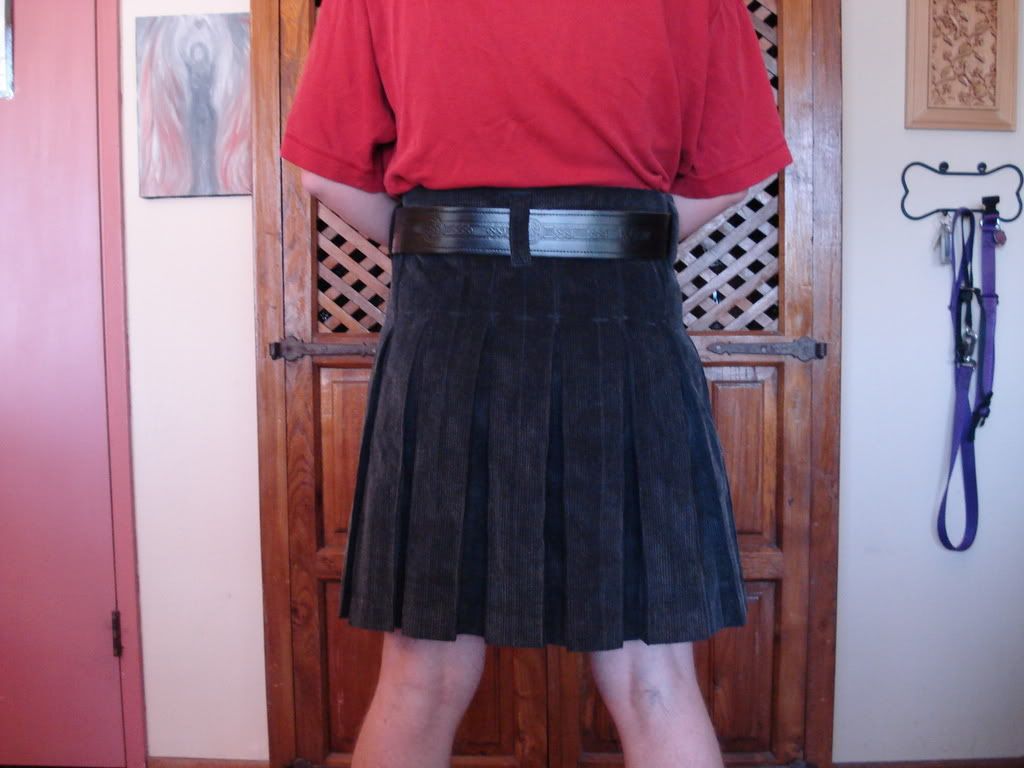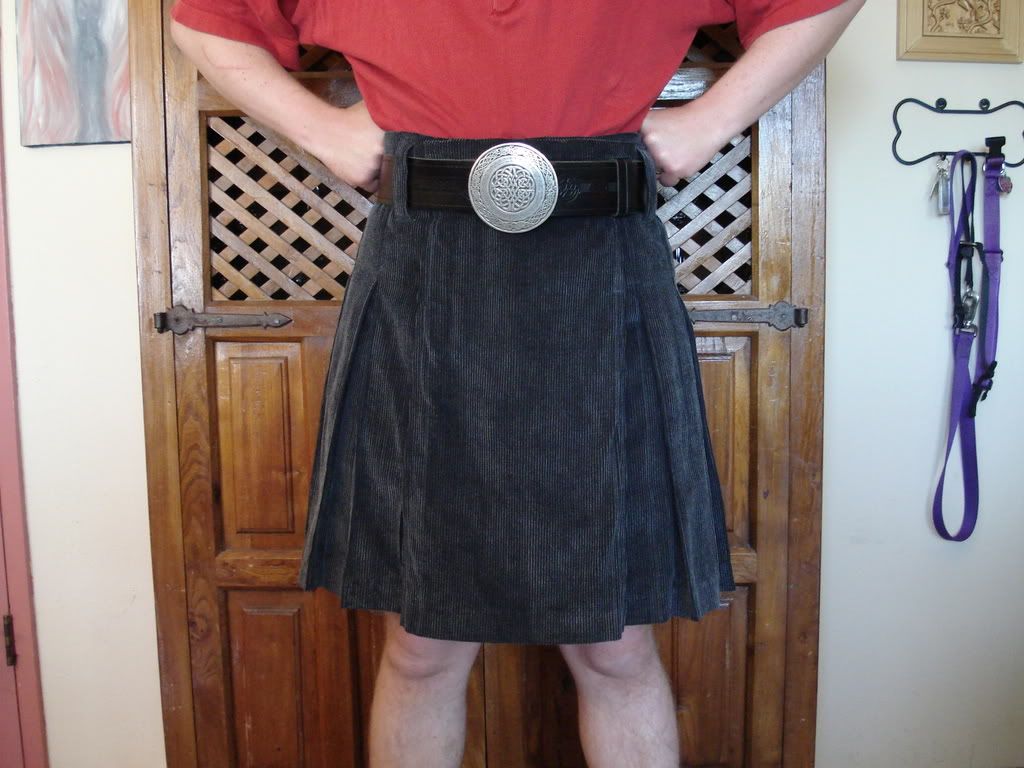|
-
15th March 07, 06:08 PM
#1
 Originally Posted by Alan H

... What law says you're only allowed to make one kilt? Get some inexpensive material at the local fabric store and crank out an X-Kilt. In 13 hours of work, you'll have a kilt, you'll understand better what goes into it, and then following Barb's instructions with that $30-$80 a yard stuff will be a LOT easier...
That's exactly what I am trying to do. Once I've done a few X-kilts and variants of X-Kilts, I'm going to buy the new edition of Barb's book and try my hand at a traditional kilt. Not that my life isn't already busy enough, but I need a very nit-picky sort of hobby to keep me sane (or is that insane?)  . .
Be well,
-
-
16th March 07, 01:45 PM
#2
The down (?) side of x-kilts
If there even is such a thing, My construction office girl Ms. Ohio wants me to do a tartan x-kilt. She likes the E-kilt but prefers "plaid".
May have to collaborate with RedJ and that blue fabric she got on X-Bay (ebay link for kilt stuff).
Bring camera on the 30th, stampede at Devil's Canyon.
CT - trunk line
-
-
16th March 07, 03:21 PM
#3
 Originally Posted by CameronTaylor

If there even is such a thing, My construction office girl Ms. Ohio wants me to do a tartan x-kilt. She likes the E-kilt but prefers "plaid".
May have to collaborate with RedJ and that blue fabric she got on X-Bay (ebay link for kilt stuff).
Bring camera on the 30th, stampede at Devil's Canyon.
CT - trunk line 
Just do a box-pleat with a full-width apron. Then call it an X-Kilt to keep her happy. A machine-sewn box pleat goes together pretty quickly, and you can do it without showing any of the stitching.
-
-
17th March 07, 11:12 AM
#4
 Originally Posted by Alan H

Just do a box-pleat with a full-width apron. Then call it an X-Kilt to keep her happy. A machine-sewn box pleat goes together pretty quickly, and you can do it without showing any of the stitching.
Interesting thought that, I just might. I'll bend your ear about it later.
CT - hmmmmm .....
-
-
3rd April 07, 10:00 PM
#5
Just thought I'd revive this thread. You guys do realize that the original demand was to post PICTURES, not excuses for why there are no pictures?!
Here are mine


Be well,
-
-
X-KILT construction pictures
Here are some pics of the construction of my sorta formal kilt. This is one of those OCD, snap every step kind of things. Let me know if there is a better place to put these.
For space and interest I will skip the "here is my ironed fabric" pic.
Here is the hem, folded twice over and then pinned, and pressed, then sewn.

Here is the framing square I used to mark all the chalk lines, the image following is the fell line marked, the pleat spacing marked, and the pleats numbered.


The marked pleats, under-apron and excess fabric:

The pinned pleats:

I sewed the pleats in two directions for ease and neatness, meaning I sewed all the right edges first and then turned the whole thing and sewed the left edges. Here it is mostly finished:

The following two pictures are of the pinned and pressed tapers before sewing:


Here is a blurry photo, trying to demonstrate how close together and neat the taper sewing is :

Finally an image of the finished tapering, demonstrating the curve that becomes apparent as foretold in Alan H's directions:

I have many many more images. Until the next post, kilt on!
-
-
16th March 07, 03:28 PM
#7
 Originally Posted by The F-H.C.A.G.

That's exactly what I am trying to do. Once I've done a few X-kilts and variants of X-Kilts, I'm going to buy the new edition of Barb's book and try my hand at a traditional kilt. Not that my life isn't already busy enough, but I need a very nit-picky sort of hobby to keep me sane (or is that insane?)  .
Be well,
I have NO doubt that when you settle yourself down to it, after making a few machine-sewn kilts, your tartan ones will be very nice. Here's a suggestion. For the first hand-sewn, get some inexpensive wool, or even PV and make a kilt out of that. Fraser and Kirkbrights remnants site is a good source for tartans that are usually 10 ounce (a bit light, but OK) but are wool/poly blends. Your skirt that I've made is Fraser and Kirkbright wool/poly. For $40 you'll have a nice tartan to work on, and make that first hand-sewn. Once you've done one of those to Barbs Instructions...
then cut loose, drop a mint on the 13 ounce or 16 ounce stuff and take no prisoners.
another hint...never, ever, ever, ever put a white stripe right on the edge of a pleat. White thread ALWAYS shows unless you are beyond anal-retentive and do microscipically fine stitching. I just about murdered someone trying to get the stitching perfect on Piper Georges kilt, 'cause I aligned the tartan (pleated to sett) so that a white stripe showed up twice in each sett-repeat, right on a pleat edge. I used white thread.....NEVER again. I'd like to hear what w2f has to say about this issue...white stripes in dark tartans/white thread.
OK, well I take all that back if you're sewing up a dress tartan.
-
-
16th March 07, 04:11 PM
#8
 Originally Posted by Alan H

...never, ever, ever, ever put a white stripe right on the edge of a pleat. White thread ALWAYS shows unless you are beyond anal-retentive and do microscipically fine stitching...
...I used white thread.....NEVER again. I'd like to hear what w2f has to say about this issue...white stripes in dark tartans/white thread.
OK, well I take all that back if you're sewing up a dress tartan.
Alan, I only have one question: Does thread come in white?
(Oh, never mind. It's that stuff one uses for basting.  ) )
Aside from the aesthetics of a white stripe on the edge of a pleat, the only other question is: Do the "shades of white" and the finish match? Just as there are different shades or finishes of black, the same is true for white. (Or, the stripe may not be white at all, but "heathered" with another color.) Even if the thread is the same shade of white, the finish could be shinier because of polyester content.
Generally, when trying to match fabric and thread, try to get thread that is a shade or two darker than the fabric because the stitches tend to blend in better. When stitching across narrow stripes, changing thread colors is usually not needed. Stitching across very wide stripes and other color blocks may require changing thread color.
Of course, the great test of stitching skill is to use contrasting thread color and do it with such "microscopically fine stitching" that the thread cannot be seen. 
w2f
(not a hijack because Alan asked for it...)
"Listen Men.... You are no longer bound down to the unmanly dress of the Lowlander." 1782 Repeal.
* * * * *
Lady From Hell vs Neighbor From Hell @ [url]http://way2noisy.blogspot.com[/url]
-
Similar Threads
-
By Raphael in forum Professional Kiltmakers Hints and Tips
Replies: 12
Last Post: 8th March 07, 10:34 PM
-
By David White in forum Professional Kiltmakers Hints and Tips
Replies: 7
Last Post: 14th September 05, 12:31 PM
-
By Dreadbelly in forum General Kilt Talk
Replies: 16
Last Post: 24th November 04, 01:38 PM
-
By RockyR in forum Professional Kiltmakers Hints and Tips
Replies: 18
Last Post: 20th October 04, 02:18 PM
-
By vwstuart in forum Kilt Advice
Replies: 5
Last Post: 6th May 04, 08:27 PM
 Posting Permissions
Posting Permissions
- You may not post new threads
- You may not post replies
- You may not post attachments
- You may not edit your posts
-
Forum Rules
|
|
.



















Bookmarks